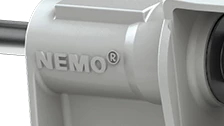NETZSCHicon
pH value
The pH value measures the acidity or alkalinity of an aqueous solution. It indicates how acidic or alkaline (basic) a solution is and is measured on a logarithmic scale ranging from zero to 14.
A pH of seven is neutral, meaning the answer is neither acidic nor basic. A pH below seven indicates an acidic solution, while a pH above seven indicates an alkaline (basic) solution. The pH scale is constructed as follows:
- pH 0-6: Acidic - The lower the pH, the more acidic the solution. Examples of acidic substances are vinegar, lemon juice and battery acid.
- pH 7: Neutral - A neutral solution has a pH of seven and is neither acidic nor basic. Pure water has a pH of seven at room temperature.
- pH 8-14: Basic (alkaline) - The higher the pH, the more basic the solution. Examples of alkaline substances are soap suds, baking soda and ammonia.
pH is essential in many fields, including chemistry, biology, environmental science, agriculture, food technology and water quality control. Many biological processes and chemical reactions depend on a specific pH range, and deviation from the optimal pH can lead to problems. To measure the pH of a solution, a pH meter or pH test strips calibrated to the pH range of the sample are used.





